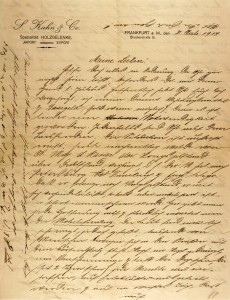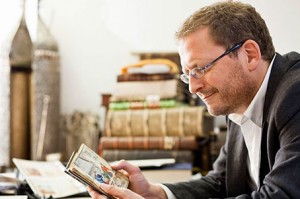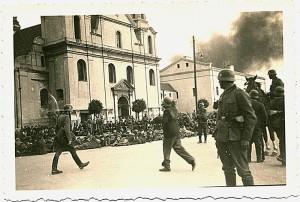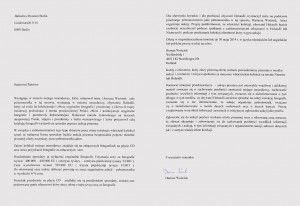A Letter from the Archive Tells of the Outbreak of War in 1914

Letter from Leo Roos to his family (first page), Frankfurt am Main, 31 July1914
Donated by Walter Roos
© Jewish Museum Berlin
“The situation is extremely serious; His Majesty the Emperor declared this afternoon that Germany is now at war.” Exactly one hundred years ago today, eighteen-year-old Leo Roos penned these lines to his parents and siblings back home in the West Palatine village of Brücken. But they were never to receive his letter, as the note on the envelope attests: Dispatch prohibited on account of the state of war. Return to sender.
Roos felt he was witnessing fateful times. He lived in Frankfurt, where he was apprenticed to a bank. He thought himself a city boy, much closer to momentous global events than his family was, off in its isolated village. He described the tense mood: → continue reading
in Conversation with Emile Schrijver, Curator of the Braginsky Collection
What made you decide to be curator of a manuscript collection?
When I studied Hebrew in Amsterdam, a lecturer took us to see the University of Leiden’s collection of medieval manuscripts. In the impressive vaults, I saw ancient manuscripts for the first time: the only manuscript of the Jerusalem Talmud (Yerushalmi), for instance, and one of the earliest Rashi manuscripts. Seeing these ancient sources, and gaining first-hand experience of living history, was overwhelming. Historical books had a strong effect on me. I subsequently studied at the Bibliotheca Rosenthaliana, the Jewish library at the University of Amsterdam, where I later began to work. A few years ago, Mr. Braginsky was looking for a curator for his first exhibition in Europe. Mutual acquaintances from the international circle of manuscript specialists put us in touch with one another. We got along well and were soon able to establish a good, trusting working relationship
What do you do as a curator of the Braginsky Collection?

Emile Schrijver and the Harrison Miscellany © and photo: Darko Todorovic, Dornbirn (A)
I take care of the collection. I am responsible for Mr. Braginsky’s new acquisitions and for his existing objects. Most new acquisitions are delivered with a short description. Others we describe and photograph, before adding them to our inventory. I carefully examine the books’ condition and, if necessary, commission their restoration. I’m also responsible for monitoring the climate in the storerooms. Inquiries concerning exhibitions and reproductions are a lot of work for us. The process of digitizing our stock is ongoing. Occasionally, scholars wish to view specific works at length. We also organize presentations on our own premises, on behalf of the European Association of Jewish Museums, for example. Public relations for events such as the Jewish Book Week in London in 2013 likewise require a great deal of preparation.
What makes the Braginsky Collection so special? → continue reading

Photograph from World War II. The sellers priced it at 3000 euros.
The financial crisis of 2007 had an impact both on the countries of Western and Eastern Europe. The złoty may still glitter but it has long since ceased to be the “golden coin” Polish currency was originally named for. Unemployment and stagnant economic growth, rising real estate prices and declining purchasing power have put the brake on Poland’s economic recovery. The Netherlands has likewise been in recession for years. Declining competitiveness, private debts, state-subsidized home ownership, the low retirement age and the expensive health care system have fed uncertainty and repeatedly paved the path to success for the Freedom Party of the populist xenophobe Geert Wilders.

The Polish letter of offer as we received it.
This downward spiral in state treasury and personal funds led a couple of Polish resp. Dutch wheeler-dealers to scrape the barrel for a bilateral business model. Crafty Dariusz Woźniok and his fly-by-night Dutch client somehow managed to get their hands on infantrymen’s photos from the Second World War—whether as thieves or buyers it is impossible to say. Maybe they were embittered by the fact that no share in the tidy profits made from material goods ever came their way, from the export of Polish geese, strawberries, potatoes and beetroot, for example, or of Dutch cheese and tulips. Maybe they hatched their business plan in an Amsterdam coffee shop and had simply smoked one hash pipe too many. Whatever the case, they figured: “It was a sure bet that snapshots of ghettos and so-called ‘Jewish actions’ in early 1940s Poland could be sold off as ‘Holocaust-ware’ to Jewish Museums—so why not make the most of an historic windfall?” → continue reading



